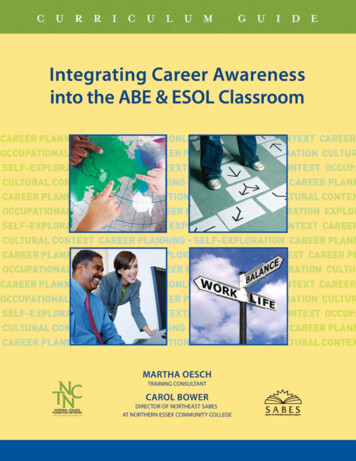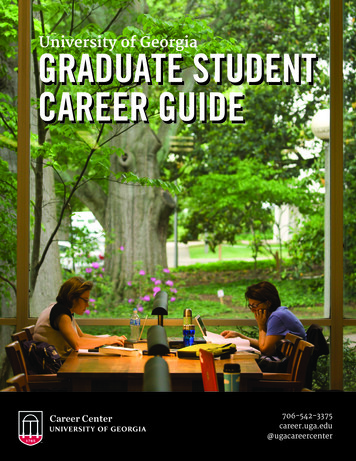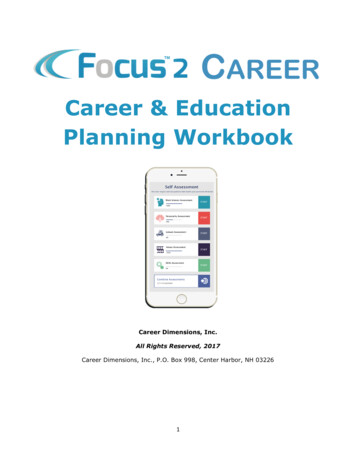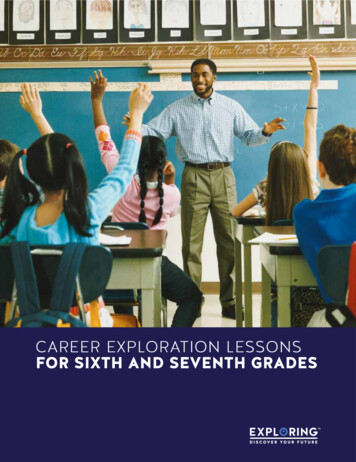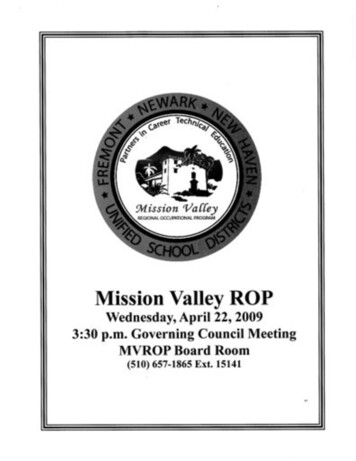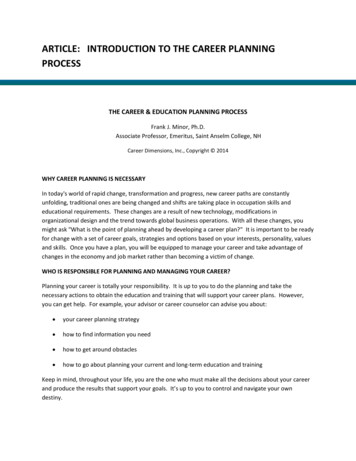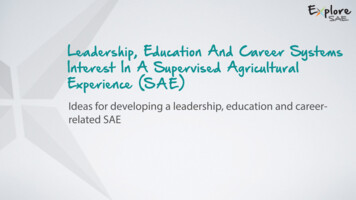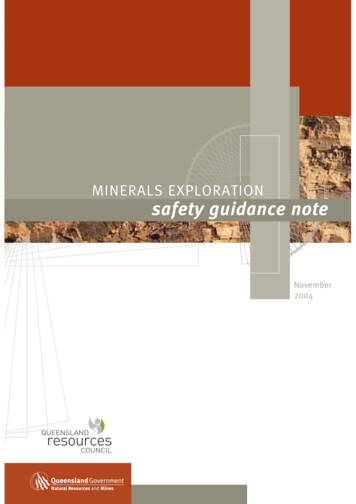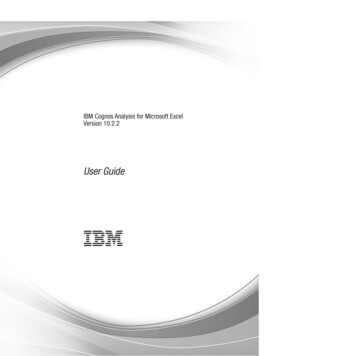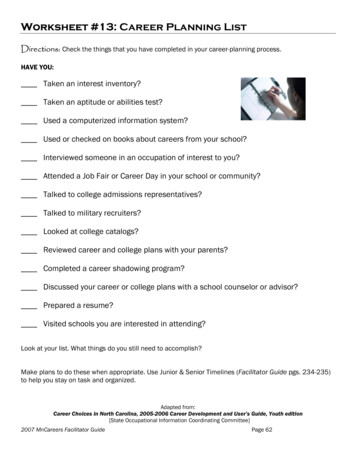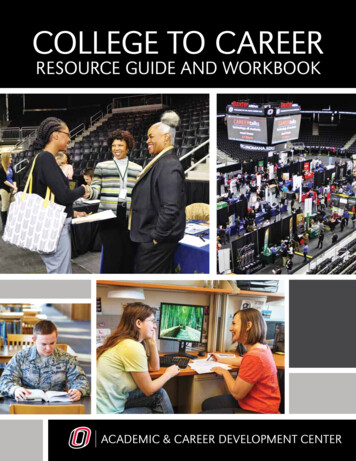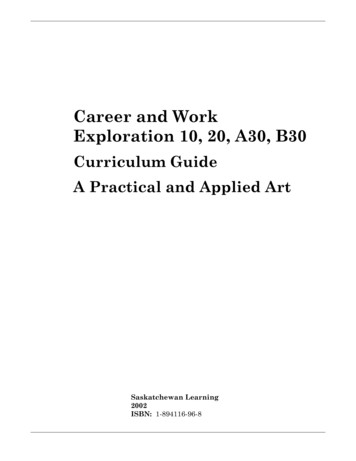
Transcription
Career and WorkExploration 10, 20, A30, B30Curriculum GuideA Practical and Applied ArtSaskatchewan Learning2002ISBN: 1-894116-96-8
AcknowledgementsSaskatchewan Learning acknowledges the contributions of the Practical and Applied Arts (PAA) ReferenceCommittee formed in 1996. Current members are:Jerry Cherneski, InstructorSIAST Palliser CampusHazel Lorenz, ConsultantLandswest S.D. #123Saskatchewan Teachers' Federation (STF)Saskatchewan Career/Work Education Association(SCWEA)Dean Lucyk, TeacherRegina RCSSD #81Saskatchewan Teachers' FederationSaskatchewan Industrial Education Association(SIEA)Barbara McKinnon, TeacherMoose Jaw S.D. #1Saskatchewan Teachers' FederationSaskatchewan Business Teachers’ Association (SBTA)Dr. Kevin QuinlanProfessor, Faculty of EducationUniversity of ReginaDoug RobertsonLloydminster RCSSD #89League of Educational Administrators, Directors andSuperintendents (LEADS)Gayleen Turner, TeacherSwift Current Comprehensive High School BoardSaskatchewan Teachers' FederationSaskatchewan Home Economics Teachers’ Association(SHETA)Previous Members:Susan Buck, SIASTLance Moen, DeanAssociated StudiesSIAST Kelsey CampusLaurent Fournier, SSTARose OlsonSaskatchewan School Trustees Association (SSTA)Dave Spencer, LEADSDr. Len ProctorProfessor, College of EducationUniversity of SaskatchewanMorris Smith, LEADSRon Wallace, SCWEADebbie Ward, SSTARon Provali, TeacherPotashville S.D. #80Saskatchewan Teachers’ FederationSaskatchewan Association for Computers in Education(SACE)Saskatchewan Learning wishes to thank many others who contributed to the development of these guidelines: Judy Berhns, assistant seconded/contracted developer/writer, Regina S.D. #4Anna Fornal, seconded/contracted developer/writer, Saskatoon S.D. #13the Practical and Applied Arts Program Teamfield test/pilot teachersother field personnel and consultantsThis document was completed under the direction of the Science and Technology Unit, Curriculum andInstruction Branch, Saskatchewan Learning.i
Table of ContentsAcknowledgements . iIntroduction . 1Philosophy and Rationale . 1Aim, Goals and Foundational Objectives . 1Common Essential Learnings Foundational Objectives .2Course Components and Considerations . 3Transistion to Work Dimensions.3Portfolios .4Extended Study .5Resources .5Assessment and Evaluation . 6Module Overview . 8Suggested Course Configuration . 9Core and Optional Modules . 12Module 1: An Introduction to Career Development (Core). 12Module 2A: Portfolio Building (Core) . 14Module 2B: Portfolios (Core). 16Module 3: Recognizing Networks (Optional) . 17Module 4: Understanding Transferable Skills (Core) . 19Module 5: Career Information (Core). 21Module 6A, B, C, D: Work Study Preparation and Follow-up Activities (Core) . 22Module 7A: Work Placement (Core) . 26Module 7B: Work Placement (Core) . 26Module 7C: Work Placement (Core) . 26Module 7D: Work Placement (Core). 26Module 8: Reflections (Core) . 27Module 9A: Occupational Health and Safety (Core) . 29Module 9B: Occupational Health and Safety (Core) . 31Module 9C: Occupational Health and Safety (Core) . 34Module 10A: Labour Standards (Core) . 35Module 10B: Labour Standards (Core) . 36Module 10C: Labour Standards (Optional) . 37Module 11: Self-Awareness and Success (Core) . 38Module 12A, B, C, D: Workplace Hazardous Materials Information System (WHMIS) (Core). 39Module 13: Recognizing Hazards (Core) . 42Module 14: Labour Market Information (Core). 46Module 15: Employability Skills and the Changing World of Work (Core). 48Module 16: Exploring Educational and Career Pathways (Core) . 50Module 17: Job Search Skills, Tools and Strategies (Core) . 51Module 18: Career Decisions (Core) . 53Module 19: Workplace Ethics, Human Rights and Equity (Core) . 55Module 20: Transitions (Optional) . 56Module 21: Earning and Understanding a Pay Cheque (Optional) . 59Module 99: Extended Study (Optional) . 60References . 61Appendix A: Career And Work Exploration Information . 63ii
Appendix B: Recordkeeping Charts for Suggested Courses. 64Appendix C: Glossary . 66Appendix D: Blueprint for Life/Work Designs Competencies by Area and Level . 71Appendix E: Sample Letters and Forms . 72Schedule “A” Work-Based Learning Consent Form . 72Student Responsibilities for Work Experience . 74Mock Interview Checklist . 75Monitoring Checklist . 76Work Experience Log Sheet . 79Student Self-Evaluation . 80Employer’s Student Performance Evaluation . 81Student Evaluation Form . 82Program Evaluation . 84Progress at a Glance . 90Career and Work Exploration – Student Assessment of Work Placement . 91Career and Work Exploration – Student Information Sheet . 92Work Placement Information/Work Place Recruitment . 93Employer Workplace Health and Safety Hazard Checklist . 94Employer Health and Safety Orientation Checklist . 96Teacher Health and Safety Assessment Summary Sheet . 97Appendix F: Career Research Interview Questions . 98Appendix G: Form 6 -- Verification of Trades Letter . 100Appendix H: Monitoring Policy . 102iii
IntroductionWithin Core Curriculum, the Practical and Applied Arts (PAA) is a major area of study that incorporatesfive traditional areas of Business Education, Computer Education, Home Economics Education, IndustrialArts, and Work Experience Education. Saskatchewan Learning, its educational partners and otherstakeholders have collaborated to complete the PAA curriculum renewal. Some PAA curriculum guidelineshave been updated; some components have been integrated, adapted, or deleted; some Locally DevelopedCourses have been elevated to provincial status; and, some new guidelines have been developed.A companion Practical and Applied Arts Handbook provides background on Core Curriculum philosophy,perspectives and initiatives. The Handbook articulates a renewed set of goals for PAA. It presentsinformation about the PAA area of study, including guidelines about work study and related Transition-toWork Dimensions. In addition, a Practical and Applied Arts Information Bulletin provides direction foradministrators and others regarding the implementation of PAA courses. Lists of recommended resourcesfor all guidelines will be compiled into a PAA Bibliography with periodic updates. An initial list ofresources for Career and Work Exploration accompanies the curriculum guide.Philosophy and RationaleCareer and Work Exploration 10, 20, A30, B30 Curriculum Guide builds on Career Guidance: A CurriculumGuide for the Middle Level (1995) in its belief that career development is a life-long process, and that acomprehensive career development program in all schools is an important strategy for assisting youth withschool and work transitions. Career and Work Exploration aims to assist students to understandthemselves, identify their unique skills and abilities, and make decisions based on occupational choicesthrough work-based learning.Career and Work Exploration contributes to the career development of Secondary Level students. Itcomplements other courses such as: Entrepreneurship 30, Life Transitions 20, 30, and Wellness 10. Thecareer exploration modules in Practical and Applied Arts curricula are supported by Career and WorkExploration 10, 20, A30, B30, as are the continued integration and articulation of career developmentconcepts into all Saskatchewan Learning curricula. Many of those concepts are introduced here.Aim, Goals and Foundational ObjectivesAimThe aim of Career and Work Exploration is to provide students with opportunities to develop and enhancethe knowledge, skills and abilities necessary to raise awareness, to access information, and to understand,shape and manage their life career development. Students will be able to expand their awareness, toexplore and to experience various work roles through work-based learning experiences.GoalsThe goals of Career Work Exploration enable students to learn about work and occupational career choicesthrough work-based learning experiences.Change Management and Life-Long Learning: To adapt to the changing employment environment,and its changing patterns and requirements.Personal Growth: To identify personal goals and personal characteristics that will need to develop toprogress toward the goals.Career Awareness: To appreciate the diversity and breadth of career development opportunities. Toexplore a wide range of career development opportunities through related work experiences.1
Transferable Skills Development: To identify and learn transferable skills in the classroom and applythem to a work-based learning environment. To develop the ability to assess situations and make decisionsconfidently. To take advantage of work-based learning to gain experience to support effective transitions.Building Networks: (accessing allies) Mentors trainers, contacts, human resources, the humandimension of career development.Personal Accountability: To develop commitment and responsibility in a workplace.Foundational ObjectivesFoundational Objectives are the major, general statements that guide what each student is expected tolearn and achieve through the modules of the curriculum. Foundational objectives indicate the mostimportant knowledge, skills, attitudes, values and abilities for a student to learn in an area of study. To understand the changing nature of life, work and career goals.To recognize that career, work and life are distinct, but not separate.To understand the relationships among work, society and the economy.To maintain balanced life and work roles.To participate in life-long learning supportive of career goals.To understand and practise the principles of the career development continuum: career awareness,career exploration and career experience.To understand, engage in and manage the career building process.To respond to change and growth as it relates to career decision making and career planning.To locate and use career and work information.To make career enhancing decisions.To increase awareness of employability skills as they relate to the work environment.To be aware of career development opportunities that exist in Saskatchewan and other provinces.To develop a responsible attitude toward work experiences in a work environment.To secure, create and maintain work placements in a safe and healthy work environment.To interact positively and effectively with others in career development.To understand the necessity of analyzing work environments for safety.To integrate classroom learning with work-based learning.The Blueprint for Life/Work Designs provides a scope and sequence of career development competencies atfour levels based on age and grade level. Level One is targeted at an Elementary Level audience; Level Twoat a Middle Level audience; Level Three at a Secondary Level audience; and, Level Four at an adultaudience. Saskatchewan Learning has adopted this scope and sequence as the list of career developmentcompetencies to be integrated across Core Curriculum, from Kindergarten through grade 12. (SeeAppendix D of this guide for a detailed list of the career development competencies.)Common Essential Learnings Foundational ObjectivesThe incorporation of the Common Essential Learnings (CELs) into the instruction of Practical and AppliedArts (PAA) curricula offers students many opportunities to develop the concepts, skills, knowledge, abilitiesand attitudes necessary to make the transition to work and adult life. The CELs establish a link betweenthe Transition–to-Work dimensions and Practical and Applied Arts curriculum content.2
Throughout the PAA curricula, the CELs Foundational Objectives are stated explicitly at the beginning ofeach module and are coded in this document, as follows:COMNUMCCTTLPSVSIL CommunicationNumeracyCritical and Creative ThinkingTechnological LiteracyPersonal and Social Values and SkillsIndependent LearningAlthough certain CELs are to be emphasized in each module, as indicated by the CELs FoundationalObjectives, other interrelated CELs may be addressed at the teacher’s discretion.Course Components and ConsiderationsCareer and Work Exploration 10, 20, A30, B30 is a non-prerequisite series of courses that blends theorybased and experiential learning components in a career development continuum of awareness, explorationand experience. Students access the community as a learning environment and thereby enhance theiropportunities for career life success.The curriculum promotes career planning and decision making. The curriculum is not intended to forcestudents to make premature choices. It aims at helping students to expand their occupational awarenessand relate their educational choices to career development while keeping a wide variety of transitionpathways open for consideration.Transistion to Work DimensionsThe Transition-to-Work dimensions included in the PAA curricula are: apprenticeship, careerexploration/development, community projects, including volunteerism, employability skills, entrepreneurialskills, occupational skills, personal accountability, processing of information, networking, teamwork andpartnerships and work study/experience.Career and Work Exploration 10This 100-hour, one-credit course may consist of 40 to 60 hours of classroom learning and 40 to 60 hours ofworkplace learning. It offers students an opportunity to access career development information in schooland in the workplace. Students are introduced to career development. They participate in a variety of selfawareness activities using specialized caraeer guidance instruments and gain valuable experiences both inand out of the classroom. Career awareness is the primary career development focus of this course.Career and Work Exploration 20This 100-hour, one-credit course consists of 30 to 50 hours of classroom learning and 50 to 70 hours ofworkplace learning. It provides students with an opportunity to explore career development as well as to dosome career planning. The career planning process is facilitated by a wide range of interactive activitiesand work experience components. The focus in Career and Work Exploration 20 is on the explorationstage of the career development continuum.Career and Work Exploration A30 and B30These 100-hour courses each consist of 25 to 30 hours of classroom learning and 70 to 75 hours of workplacelearning. Career and Work Exploration A30 and B30 maximize opportunities for students to access theworkplace. These courses offer opportunities for students to experience career choices and to developentry level skills in a workplace setting.3
PortfoliosA personal career portfolio is a valuable organizer of student projects and assignments. It encouragesstudents to collect examples of their work as they progress through the various activities, labs and projects.Selecting particular items to include in a portfolio encourages students to reflect on what they have learnedor accomplished and what they have yet to learn. Portfolio items may include: journal notes, drafts,photographs, audio or video tapes, computer disks, sketches and drawings, etc. Portfolios may be used forpeer, teacher, or self-assessment, and as a means to present selected works to parents, post-secondaryinstitutions, or potential employers. In addition, the portfolio can demonstrate the link between home,school and community in the student’s education. Each student should have a portfolio representing his orher work during the course. A portfolio can be developed, maintained, and expanded throughout astudent’s secondary level education.The portfolio helps students: reflect on personal growth and accomplishment track the development of work-related skills and knowledge see links with home, school and community education and activities collect materials to prepare applications for post-secondary education and scholarship programentrance collect materials to prepare for employment applications focus on career planning.The portfolio helps teachers: provide a framework for independent learning strategies for the student communicate student achievement from one school year to another in a specific area of study identify career planning needs for students assess and evaluate the student’s progress and achievement in a course of study relate the skills taught in the classroom to the usefulness of those skills in the workplace.The portfolio helps post-secondary institutions: determine suitable candidates for awards and scholarships evaluate candidates for program entrance evaluate prior learning for program placement.The portfolio helps the community: reflect on the involvement in a student’s education and the support offered to learners demonstrate the links with the home, school and community in education.The portfolio helps potential employers: identify employable skills desired in future employees provide evidence of the knowledge and skill development of potential employees.Working PortfolioStudents should collect work over time in a working folder. Students should also keep a journal ofobservations, critiques, ideas and reflections as part of their working portfolio. Items in this portfolio maybe used for the purpose of reflection, for ongoing and summative evaluations, peer, teacher and selfevaluations, and for documenting skill development and mastery.Working portfolios may be used for purposes of conferencing between student and teacher, student andparent, teacher and parent, teacher and teacher, or student and student. When a teacher examines astudent’s portfolio in order to make a decision regarding student progress, the information it contains maybecome documentation for the evaluation.A daily journal may also become a part of a working portfolio as a means of tracking the student’s use oftime and to record progress. This will provide the student with a focus for self-directed or independentlearning as well as an anecdotal record for part of the course evaluation.4
Presentation PortfolioTo compile a presentation portfolio, a student should select items from the working portfolio. Thepresentation portfolio should cover the range of a student’s experiences and should display his or her bestefforts. A teacher could use presentation portfolios for assessment. It is strongly suggested that studentsat the 30 level prepare a presentation portfolio suitable for submission to potential employers or postsecondary institutions.Through collecting, selecting and reflecting, students become capable of compiling presentation portfoliosthat display their best collection of work.Extended StudyThe extended study module is designed to provide schools with an opportunity to meet current and futuredemands that are not provided by current modules in the PAA curriculum.The flexibility of this module allows a school or school division to design one new module per credit tocomplement or extend the study of existing core modules and optional modules configured to meet thespecific needs of students or the community.The list of possibilities for topics of study or projects for the extended study module is varied. Theseoptional extended study module guidelines should be used to strengthen the knowledge, skills andprocesses advocated in the Practical and Applied Arts curriculum.It is recommended that a summary of any extended study module be sent to the Regional Superintendent ofCurriculum and Instruction.For more information on the extended study module, refer to the Practical and Applied Arts Handbook.ResourcesTo support the principle of Resource-based Learning a variety of instructional resources have beenevaluated and recommended to support the teaching and learning of Career and Work Exploration. SeeCareer and Work Exploration 10, 20, A30, B30: An Initial List of Implementation Materials for a list ofannotated resources. Teachers should also consult the comprehensive PAA bibliography. The annualLearning Resource Materials Update can also provide information about new materials evaluated since thecurriculum was printed.To order materials, except videos, teachers should check the Learning Resource Distribution Centre (LRDC)catalogue. An on-line ordering service is available at lrdc.sasked.gov.sk.ca/.The on-line version of this curriculum and its accompanying list of implementation materials is accessibleat www.sasked.gov.sk.ca/docs/paa.html. It will be “Evergreened”, or renewed as appropriate.5
Assessment and EvaluationThe student in Career and Work Exploration will be required to develop a personal career portfolio.Student assessment and evaluation is an important part of teaching, as it allows the teacher to plan andadapt instruction to meet the specific needs of each student. It also allows the teacher to discuss thecurrent successes and challenges with students and report progress to the parent or guardian. It isimportant that teachers use a variety of assessment and evaluation strategies to evaluate student progress.Additional information on evaluation of student achievement can be found in the Saskatchewan Learningdocuments entitled Student Evaluation: A Teacher Handbook (1991) and Curriculum Evaluation inSaskatchewan (1991).It is important that the teacher discuss with students the evaluation strategies to be used in the course,when the evaluation can be expected to occur, the weighting of each evaluation strategy, and how it relatesto the overall student evaluation. The weighting of the evaluation strategy should be determined inrelation to the amount of time spent and emphasis placed on each area of the course, as suggested in thiscurriculum guide.As discussed in the Practical and Applied Arts Handbook, there are three main types of student evaluation:diagnostic, formative and summative.Diagnostic evaluation usually occurs at the beginning of the school year or before a unit of instruction, toidentify prior knowledge, interests or skills of students about the subject area.Formative evaluation is an ongoing classroom process that keeps students and educators informed ofstudents’ progress.Summative evaluation occurs most often at the end of a module, to determine what has been learned over aperiod of time.For more information about student evaluation refer to the Practical and Applied Arts Handbook orStudent Evaluation: A Staff Development Handbook (Saskatchewan Professional Development Unit, 1999).For information about program evaluation refer to the Saskatchewan School-Based Program EvaluationResource Book (1989).For information about curriculum evaluation refer to Curriculum Evaluation in Saskatchewan(Saskatchewan Education, 1991).6
Suggested Evaluation StrategyCareer and Work Exploration 10Portfolio Assessment:Tests and Quizzes:Self-Assessment Instruments:Career Information Research:Work Placement Assessments:(teacher, employer and stu
The goals of Career Work Exploration enable students to learn about work and occupational career choices through work-based learning experiences. Change Management and Life-Long L
